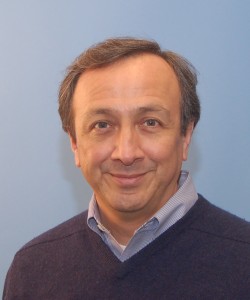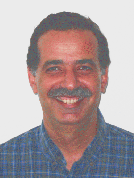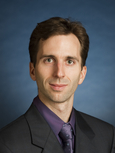14-th ACM MSWiM 2011
Keynote Speakers
In addition to scientific papers, the MSWiM 2011 program includes distinguished Keynote Speakers.
Keynote title: Redefining Routing and Channel Access in Ad Hoc Networks
Prof. J.J. Garcia-Luna-Aceves
Jack Baskin School of Engineering - Computer Engineering Dept.
University of California at Santa Cruz
Keynote abstract:
There has been considerable work on the architecture and protocols of wireless networks since the inception of the ALOHA system and the DARPA packet radio network approximately 40 years ago. However, the design choices that have been made for wireless networks are derivatives of protocols designed for wireline networks and are such that: (a) channel access is either very inefficient and unable to support multimedia traffic across multiple hops, or requires complex clock synchronization to support scheduling schemes based on time division of the channel and dynamic channel reuse; (b) the routes established in wireless networks have no correlation to the transmission schedules used over the wireless links forming those routes, which reduces the efficiency with which flows can be forwarded; and (c) the mechanisms used for information dissemination in wireless ad hoc networks do not scale with the size or dynamics of the network.
In this talk, I argue that the way in which naming, addressing, routing and channel access are done in wireless networks must be redefined from the ground up in order for these networks to scale and perform much more efficiently than they currently do. This redesign must take into account the facts that: (a) nodes do not attach to the network at static points and need not be grouped in stable sets; (b) wireless links do not operate in isolation from one another; (c) establishing transmission schedules and routes are intimately related to one another; (d) SSooding must be eliminated in the signaling of routing protocols; and (e) routing and channel access protocols do not have to use static identifiers that have no relationship to their operation.
I summarize recent results on automatic incremental routing (AIR) and harmonic channel access, which follow the above design guidelines. AIR attains efficient routing in large networks without the use of traditional routing tables or flooding, and supports unicast and multicast routing using the same signaling. Harmonic channel access attains distributed transmission schedules based on circular permutations of identifiers of those entities competing for the shared channel, which need not be node identifiers.
Short Bio: Prof. J.J. Garcia-Luna-Aceves received the B.S. degree in Electrical Engineering from the Universidad Iberoamericana, Mexico City, Mexico in 1977; and the M.S. and Ph.D. degrees in Electrical Engineering from the University of Hawaii at Manoa, Honolulu, HI in 1980 and 1983, respectively. He holds the Jack Baskin Endowed Chair of Computer Engineering at the University of California, Santa Cruz (UCSC), is Chair of the Computer Engineering Department, and is a Principal Scientist at the Palo Alto Research Center (PARC). Prior to joining UCSC in 1993, he was a Center Director at SRI International (SRI) in Menlo Park, California. He has been a Visiting Professor at Sun Laboratories in Menlo Park, California, and a Principal of Protocol Design at Nokia in Mountain View, California.
Dr. Garcia-Luna-Aceves received the IEEE Computer Society Technical Achievement Award in 2011 ``for pioneering contributions to the theory and design of communication protocols for ad-hoc wireless networks." He is a fellow of the Institute of Electrical and Electronics Engineers (IEEE), the Association for Computing Machinery (ACM), and the American Association for the Advancement of Science (AAAS).
He is the co-recipient of the IEEE Fred W. Ellersick 2008 MILCOM Award for best unclassified paper. He is also co-recipient of Best Paper Awards at the the European Wireless Conference 2010, IEEE MASS 2008, SPECTS 2007, IFIP Networking 2007, and IEEE MASS 2005 conferences, and of the Best Student Paper Award of the 1998 IEEE International Conference on Systems, Man, and Cybernetics. He received the SRI International Exceptional-Achievement Award in 1985 and 1989, and is listed in Marquis Who's Who in America and Who's Who in The World.
Dr. Garcia-Luna-Aceves holds 36 U.S. patents, and has published three books and more than 420 journal and conference papers. He has directed 30 Ph.D. theses and 28 M.S. theses since he joined UCSC in 1993. He has been the General Chair of the ACM MobiCom 2008 Conference; the General Chair of the IEEE SECON 2005 Conference; Program Co-Chair of ACM MobiHoc 2002 and ACM MobiCom 2000; Chair of the ACM SIG Multimedia; General Chair of ACM Multimedia '93 and ACM SIGCOMM '88; and Program Chair of IEEE MULTIMEDIA '92, ACM SIGCOMM '87, and ACM SIGCOMM '86. He has served in the IEEE Internet Technology Award Committee, the IEEE Richard W. Hamming Medal Committee, and the National Research Council Panel on Digitization and Communications Science of the Army Research Laboratory Technical Assessment Board.
He directs the Computer Communication Research Group (CCRG) and the Network Sciences Institute (NSI).
Keynote abstract:
Until recently, the vast majority of research in wireless and mobile networks focused on so-called Mobile Ad Hoc Networks (MANETs), where relatively stable end-to-end paths are the norm. More recently, research has focused on a different, Intermittently Connected Network (ICN) paradigm, where stable end-to-end paths are the exception and intermediate nodes may store data while waiting for transfer opportunities towards the destination. Protocols developed for MANETs generally do not work in ICNs since the connectivity assumptions are so different. In this talk I will first give an overview of ICNs and the types of challenges involved in their design and operation. I will then discuss our work in the WAM (wireless and mobile) Continuum project which is based on the simple but powerful observation that MANETs and ICNs fit into a continuum that generalizes these two previously distinct categories. Building on this observation, our work develops a framework that goes further to scope the entire space of wireless and mobile networks. I will summarize two efforts: The first gives clues of the fundamental relationship between ICNs and MANETs by unifying the use of message ferrying in ICNs with the well-known use of connected dominating set-based routing in MANETs. The second effort aims at developing a formal WAM Continuum framework where a network can be characterized by its position in this continuum. Certain network equivalence classes can be defined over subsets of this WAM continuum and this classification can be used to inform network design and operation. I will demonstrate how the unified view enabled by our framework can be used as a systematic, formal descriptive and evaluative tool.
Short Bio: Mostafa Ammar received the S.B. and S.M. degrees from the Massachusetts Institute of Technology in 1978 and 1980, respectively and the Ph.D. in Electrical Engineering from the University of Waterloo, Ontario, Canada in 1985. For the years 1980-82 he worked at Bell-Northern Research (BNR), first as a Member of Technical Staff and then as Manager of Data Network Planning.
Dr. Ammar's research interests are in the areas of computer network architectures and protocols, distributed computing systems, and performance evaluation.
He is the co-author of the textbook "Fundamentals of Telecommunication Networks," published by John Wiley and Sons. He is also the co-guest editor of April 1997 issue of the IEEE Journal on Selected Areas in Communications on ``Network Support for Multipoint Communication." He also was the Technical Program Co-Chair for the 1997 IEEE International Conference on Network Protocols, 2002 Networked Group Communication Workshop, 2006 Co-Next Conference, and 2007 ACM SIGMETRICSConference.
Dr. Ammar is the holder of a 1990-1991 Lilly Teaching Fellowship and received the 1993 Outstanding Faculty Research Award from the College of Computing. He served as the Editor-in-Chief of the IEEE/ACM Transactions on Networking (1999-2003) and served on the editorial board of Computer Networks (1992-1999).
He is a Fellow of the IEEE and a Fellow of the ACM.
INVITED TALK
Keynote title: Evaluating Cooperative ITS Applications for Sustainable and Safe Mobility with iTETRIS
Prof. Jerome Härri
Mobile Communication Department
EURECOM
Keynote abstract:
We see today urban traffic growing faster than the capacity of road infrastructures and posing a challenge to traffic safety and to the sustainability of our mobility. In this context, cooperative mobility strategies are expected to become a key enabler for a better usage of the available road infrastructures. Considering the estimation by the Americal Automotive Association of the yearly cost of traffic safety to 160 billion USD, or the yearly cost of traffic congestion to 50 billion EUR by the European Commission, local road authorities are facing a strategic challenge to develop and propose cooperative ITS applications to the public. The question is how can the actual worth of investment and effectiveness of cooperative ITS applications on city road traffic be estimated? To answer this question, new tools capable of providing realistic and large scale assessments and guidelines to road authorities are required. To this aim, we need to define an extensible architecture allowing the interactions of realistic models spanning from wireless communication to traffic and mechanical engineering, and provide a modular integration methodology of cooperative ITS applications. In this talk, we present the outcome of the recently completed work of the European FP7 project iTETRIS during which an open, ETSI standard compliant, and flexible ITS simulation platform has been developped. We describe the modeling challenges, design choices, selected scenarios, and illustrate the benefits and functionalities of the iTETRIS platform through the integration of exemplary key cooperative ITS applications. We further discuss future evolutions, trends, and potential roles of simulations and the iTETRIS platform to reach sustainable and safe mobility resulting in economical, social and ecological wealth improvements.
Short Bio:
Jerome Harri is an Assistant Professor at the Mobile Communication Group at EURECOM, France, and conducting research in wireless vehicular networks. Previously, he led a Traffic Telematics Junior Research Group at the Institute of Telematics of the Karlsruhe Institute of Technology (KIT), Germany. His research interests are related to the investigation of cooperative ITS strategies and to the characterization of the mutual relationship between vehicular mobility and inter-vehicular communication. J´erˆome has been Co-Chair of the special session on traffic telematics at IEEE PIMRC’09, has served as Demo Chair and TPC Co-chair of the IEEE Conference on Wireless Vehicular Communications (WiVeC) 2008 and 2010 respectively, and is the author of the chapter on ”Vehicular Mobility Modeling for VANET” in the book ”VANET: Vehicular Applications and Inter-Networking Technologies”, (Eds. H. Hartenstein and K. Laberteaux) published by Wiley in 2010. He has been involved in the EU FP7 project iTETRIS, where he contributed to the architecture and the development of ITS applications and ITS infrastructure deployment strategies. He is now involved in the French Field Operational Test (FOT) project SCOREF and the smart grid project VELCRI with simulation-related evaluations of cooperative ITS applications based on the iTETRIS Platform. He is actively participating to standardization activities of the ETSI TC ITS and of the CAR 2 CAR Communication Consortium. J´erˆome holds a M.Sc. degree and a Dr. `es sc. degree in telecommunication from the Swiss Institute Technology (EPFL), Lausanne, Switzerland.


